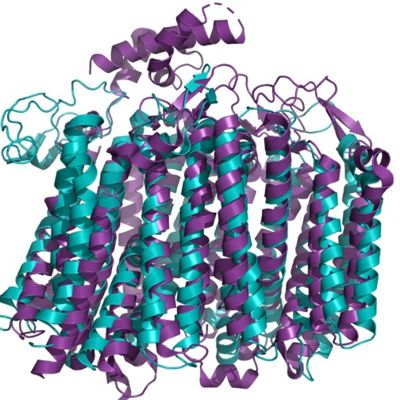User:Carson E Middlebrook/Sandbox 1
From Proteopedia
< User:Carson E Middlebrook(Difference between revisions)
| (2 intermediate revisions not shown.) | |||
| Line 1: | Line 1: | ||
=Bd Oxidase from ''Geobacillus thermodenitrificans''= | =Bd Oxidase from ''Geobacillus thermodenitrificans''= | ||
| - | <StructureSection load='5DOQ' size='350' frame='true' side='right' caption='Bd Oxidase from Geobacillus thermodenitrificans 5DOQ' scene= | + | <StructureSection load='5DOQ' size='350' frame='true' side='right' caption='Bd Oxidase from Geobacillus thermodenitrificans 5DOQ' scene=’'83/838655/Bdoxidase_structure_full/1'> |
== Introduction == | == Introduction == | ||
| + | <scene name='83/838655/Bdoxidase_structure_full/2'>TextToBeDisplayed</scene> | ||
== Function == | == Function == | ||
== Active Site == | == Active Site == | ||
| - | The active site for Bd Oxidase in ''Geobacillus thermodenitrificans'' is located in subunit Cyd A. The site consists of three iron hemes: Heme B558, Heme B595, and Heme D | + | The active site for Bd Oxidase in ''Geobacillus thermodenitrificans'' is located in subunit Cyd A. The site consists of three iron hemes: Heme B558, Heme B595, and Heme D that are held together in a rigid triangular <scene name='83/838655/Hemes/1'>arrangement</scene> due to van der wals interactions. The length between each heme's central iron is relatively constant which serves to shuttle protons and electrons from one heme to another efficiently. It is suggested that Heme B558 acts as an electron acceptor to the extracellular side and Heme B559 acts as a proton acceptor on the intracellular side. It is then proposed that both heme B558 and B595 shuttle their respective ions directly to Heme D based on this being the shortest pathway (reference). Heme D is then suggested to be the oxygen binding site due to proximity and orientation to the exterior surface of the protein. |
== Relevance == | == Relevance == | ||
Current revision
Bd Oxidase from Geobacillus thermodenitrificans
| |||||||||||
References
- ↑ Safarian S, Rajendran C, Muller H, Preu J, Langer JD, Ovchinnikov S, Hirose T, Kusumoto T, Sakamoto J, Michel H. Structure of a bd oxidase indicates similar mechanisms for membrane-integrated oxygen reductases. Science. 2016 Apr 29;352(6285):583-6. doi: 10.1126/science.aaf2477. PMID:27126043 doi:http://dx.doi.org/10.1126/science.aaf2477
Student Contributers
- Carson Middlebrook
- Emma Harris

